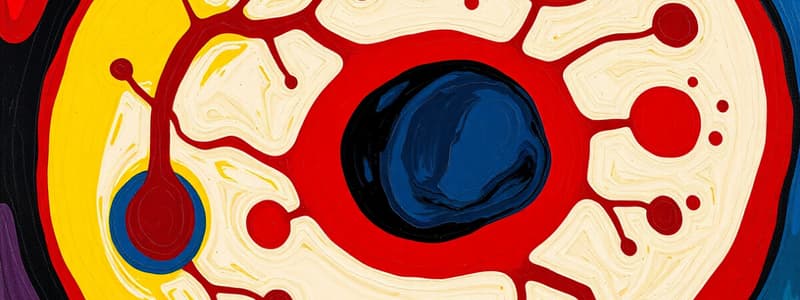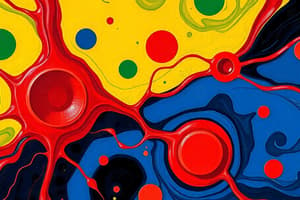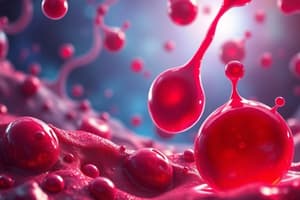Podcast
Questions and Answers
What is the primary role of von Willebrand factor in hemostasis?
What is the primary role of von Willebrand factor in hemostasis?
- To release serotonin and thromboxane A2
- To facilitate platelet adhesion to collagen (correct)
- To cause blood vessels to vasodilate
- To activate thrombin from prothrombin
Which factors are involved in the intrinsic pathway of coagulation activation?
Which factors are involved in the intrinsic pathway of coagulation activation?
- Factors VIII, X, and thrombin
- Factors XIII, VII, and V
- Factors IX, XI, and XII (correct)
- Factors I, II, and III
What is the primary chemical mediator responsible for immediate vasoconstriction during hemostasis?
What is the primary chemical mediator responsible for immediate vasoconstriction during hemostasis?
- Collagen
- Prothrombin
- Serotonin (correct)
- Fibrin
What happens when thrombin activates fibrinogen?
What happens when thrombin activates fibrinogen?
What characterizes the duration and nature of vasoconstriction during hemostasis?
What characterizes the duration and nature of vasoconstriction during hemostasis?
Flashcards
Hemostasis
Hemostasis
The first step of wound healing, hemostasis is the process that stops bleeding by forming a blood clot within a damaged blood vessel.
Platelet Degranulation
Platelet Degranulation
When platelets stick to collagen, they release chemicals like ADP, serotonin and thromboxane A2, which cause vasoconstriction (narrowing of blood vessels) and make other platelets sticky, leading to clot formation.
Prothrombin Activation
Prothrombin Activation
Prothrombin, an inactive enzyme, is converted into thrombin, an active enzyme, through a series of steps, including the intrinsic and extrinsic pathways.
Fibrinogen Conversion
Fibrinogen Conversion
Signup and view all the flashcards
Vasoconstriction in Hemostasis
Vasoconstriction in Hemostasis
Signup and view all the flashcards
Study Notes
Hemostasis: Blood Clotting
- Hemostasis is the process that stops bleeding by keeping blood contained within damaged blood vessels. It's the first stage of wound healing.
Platelet Activation
- Endothelial cells release von Willebrand factor, causing platelets to adhere to exposed collagen.
- Platelet adherence triggers degranulation, releasing ADP, serotonin, and thromboxane A2.
- Serotonin and thromboxane A2 cause vasoconstriction (narrowing of blood vessels).
- ADP and thromboxane A2 make more platelets sticky, promoting further aggregation.
- These reactions happen within seconds of injury.
Coagulation Cascade
- Prothrombin (inactive thrombin) is activated by either the intrinsic or extrinsic pathway.
- Activation of thrombin converts fibrinogen (a plasma protein) into fibrin (an insoluble protein), forming a blood clot.
- The intrinsic pathway is triggered by contact with foreign surfaces (e.g., damaged blood vessels). Factor XII is activated by this contact, initiating a cascade that involves factors XI, IX, VIII, and X.
- The extrinsic pathway (details omitted—no need to repeat similar steps) is also involved.
- Common pathway steps occur after factor X activation, including the activation of thrombin and the formation of the blood clot. Calcium ions (Ca) and platelet phospholipid factor (PF3) are required for this final stage.
Vasoconstriction
- Vasoconstriction is the spontaneous, immediate, and temporary narrowing of blood vessels at the site of injury.
- It lasts a maximum of 30 minutes.
- Mechanisms include myogenic (smooth muscle contraction) and neurogenic (nerve stimulation) responses.
- Serotonin is one of the chemicals contributing to vasoconstriction.
Studying That Suits You
Use AI to generate personalized quizzes and flashcards to suit your learning preferences.




